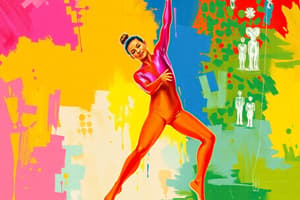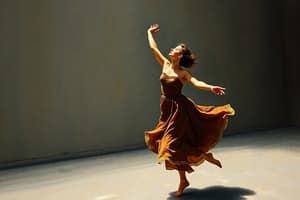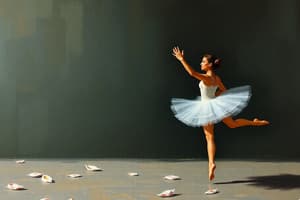Podcast
Questions and Answers
Which of these dance forms emerged during the Renaissance?
Which of these dance forms emerged during the Renaissance?
- Contemporary
- Jazz
- Ballet (correct)
- Hip-hop
Which of these movements are NOT locomotor?
Which of these movements are NOT locomotor?
- Skipping
- Swinging (correct)
- Jumping
- Running
Which of these dance forms emerged during the 20th century?
Which of these dance forms emerged during the 20th century?
- Hip-hop (correct)
- Court Dances
- Waltz
- Folk Dances
Which of these is an example of a manipulative movement?
Which of these is an example of a manipulative movement?
During which historical period did dance primarily serve religious and entertainment purposes?
During which historical period did dance primarily serve religious and entertainment purposes?
Which of the following activities would NOT be considered a locomotor movement?
Which of the following activities would NOT be considered a locomotor movement?
What type of movement is best described as controlling an object with your body?
What type of movement is best described as controlling an object with your body?
A student is performing a pirouette. What type of movement is this?
A student is performing a pirouette. What type of movement is this?
Which of the following is NOT a characteristic of locomotor movements?
Which of the following is NOT a characteristic of locomotor movements?
Which of the following activities is a combination of locomotor and manipulative movements?
Which of the following activities is a combination of locomotor and manipulative movements?
Flashcards
Locomotor Movements
Locomotor Movements
Movements that involve traveling from one place to another, such as walking or running.
Non-Locomotor Movements
Non-Locomotor Movements
Stationary movements that do not involve traveling, like bending or twisting.
Manipulative Movements
Manipulative Movements
Movements that involve controlling an object, such as throwing or dribbling a ball.
Examples of Locomotor Movements
Examples of Locomotor Movements
Signup and view all the flashcards
Examples of Non-Locomotor Movements
Examples of Non-Locomotor Movements
Signup and view all the flashcards
Ancient Dance
Ancient Dance
Signup and view all the flashcards
Medieval Dance
Medieval Dance
Signup and view all the flashcards
Renaissance Court Dances
Renaissance Court Dances
Signup and view all the flashcards
Study Notes
Fundamentals of Movement
-
Locomotor Movements:
- Moving from one place to another.
- Examples: walking, running, jumping, skipping
-
Non-Locomotor Movements:
- Stationary movements.
- Examples: bending, twisting, swinging, swaying
-
Manipulative Movements:
- Controlling an object.
- Examples: throwing, catching, dribbling, kicking
Studying That Suits You
Use AI to generate personalized quizzes and flashcards to suit your learning preferences.



